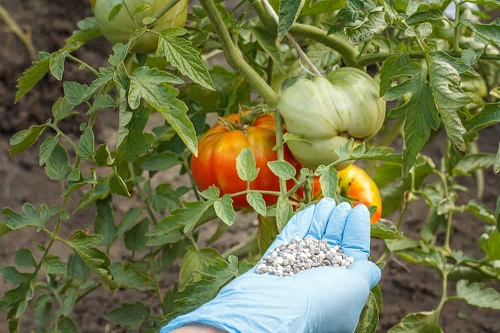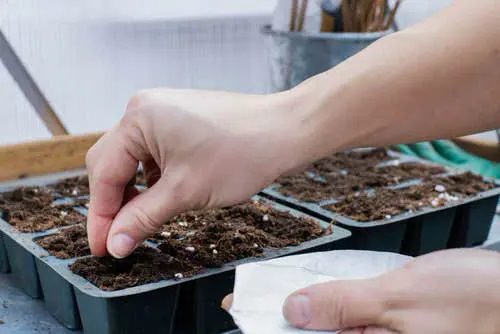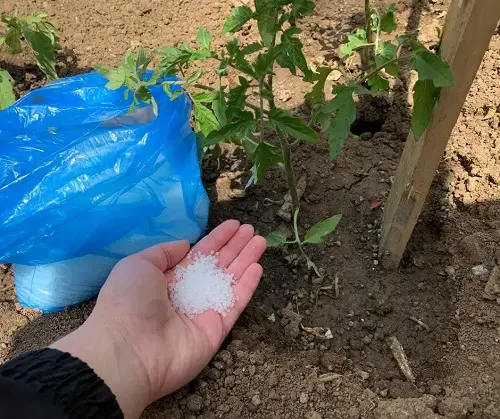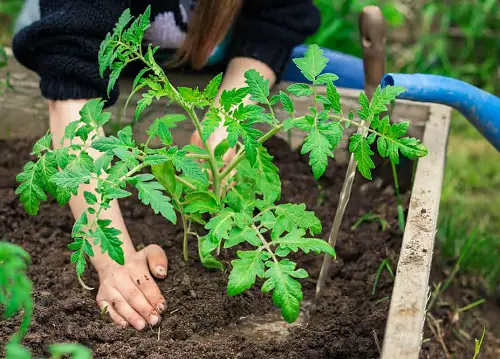Discover the little-known secret to producing larger, tastier, and more vibrant tomatoes with the amazing Epsom Salt for Tomatoes Uses.
Are you tired of lusterless tomatoes that never seem to reach their full potential? Look no further than your own pantry for a simple solution: Epsom salt. That’s right; this common household item can work wonders for your tomato plants, leading to bigger, juicier, and more flavorful fruits. Here is our guide on Epsom Salt for Tomatoes and how to apply it to your own garden for a bountiful harvest.
Learn How to Grow Spoon Tomatoes (World’s Smallest Tomatoes)
What is Epsom Salt?
Epsom salt, also known as magnesium sulfate, is a naturally occurring mineral compound that has a wide range of uses, both in the home and garden. It’s composed of magnesium, sulfur, and oxygen, which are all essential nutrients for plant growth.
Magnesium is crucial for the production of chlorophyll and plays a vital role in photosynthesis. Sulfur, on the other hand, is essential for protein synthesis and helps uptake other nutrients, such as nitrogen and phosphorus.
Epsom salt has become a popular choice for gardeners looking to boost the health and productivity of their plants. It can be used to improve the health of your garden soil, prevent plant diseases, deter pests, and increase yield. But is Epsom salt good for tomato plants? And what does it do for tomato plants? Let us take a look at Epsom Salt for Tomato and its benefits.
Epsom Salt for Tomatoes
1. Epsom Salt to Minimize Tomato Transplant Shock

When you’re transplanting your tomato plants, they may experience some shock and become weak or withered. Thankfully, Epsom salt can help minimize this shock and keep your plants healthy.
Before transplanting, mixing Epsom salt for tomatoes is required. Add one small teaspoon of it in the growing medium per pot, and water your tomato plants well.
This will help your plants adjust to their new environment and avoid any unnecessary stress. So, give your tomato plants a helping hand with Epsom salt to minimize transplant shock and ensure they grow strong and healthy.
2. Epsom Salt to Improve Tomato Flavor
When it comes to growing tomatoes, flavor is a key consideration for many gardeners. And if you want your tomatoes to be packed with flavor, Epsom salt can be a great help.
The micronutrients magnesium and sulfur found in Epsom salt can enhance the flavor of the tomatoes. Proper and consistent fertilization is important for juicy, flavorful tomatoes, but a little extra boost from Epsom salt doesn’t hurt either.
You can add a tablespoon of Epsom salt per foot of plant height to your watering can or apply it through foliar spraying to help your tomato plant absorb micronutrients more efficiently.
By doing this once a month, your plant will have all the necessary micronutrients it needs to produce the tastiest tomatoes come harvest time. Adding Epsom salt is a proven fact, and it’s a safe and easy way to enhance the flavor of your tomatoes without the use of chemicals or expensive additives.
Learn Growing Heirloom Tomatoes In Pots
3. Improve Seed Germination
Starting your tomato plants from seed can be a rewarding experience, but it can also be a bit of a challenge. Fortunately, Epsom salt can help improve the germination rate and growth of your tomato seeds.
But how much Epsom salt for tomato plants? Sprinkle up to one cup of Ultra Epsom Salt per 100 square feet of garden soil and work it into the soil. Epsom salt is highly beneficial for tomatoes when planting seeds.
The magnesium and sulfur present in the Epsom salt will help promote healthy root development and overall plant growth, ensuring that your tomato plants get off to a great start. With this simple trick, you can enjoy a bountiful harvest of delicious and nutritious homegrown tomatoes. Learn how to DIY here.
4. Epsom Salt for Tomatoes to Boost Growth
Epsom salt can help accelerate the growth of your tomato plants by increasing their magnesium levels. Magnesium is a crucial nutrient that plants need to produce chlorophyll.
On the other hand, Epsom salt also enhances micronutrient absorption, aiding the plant. Simply sprinkle a tablespoon of Epsom salt around the base of your tomato plants before watering, and watch them flourish.
5. Deter Pests
If you’re tired of pests munching on your tomato plants, Epsom salt can rescue you! Epsom salt has been known to deter common garden pests like beetles and slugs, making it a natural and non-toxic solution.
But how much Epsom salt per gallon of water for tomatoes? Simply mix a cup of Epsom salt with five gallons of water, ensuring the salt is well-dissolved, and then apply this Epsom salt spray for tomatoes to the foliage with a pump sprayer.
This will create an abrasive barrier on the plants, making it difficult for pests to crawl or slide across the leaves. It’s an easy and affordable way to keep your tomato plants healthy and pest-free. Learn how to get rid of tomato hornworms here.
6. Epsom Salt to Fix Yellowing Tomato Leaves
If you’re noticing yellow leaves on your tomato plants, it’s important to address the issue before it spreads and causes further damage. Luckily, Epsom salt can help you fix the problem quickly and easily.
Mix a teaspoon of Epsom salt per liter (quarter gallon) of water in a spray bottle, and then apply the solution to your tomato plants every two weeks, making sure to wet the foliage using a fine spray setting.
The Epsom salt will be quickly absorbed by the leaves, providing the nutrients your plants need to thrive and preventing the yellowing of the leaves. This simple solution can help you maintain healthy, vibrant tomato plants throughout the growing season. Here is the complete DIY to create the solution.
Here are DIY Tomato Cage, Trellis & Stake Ideas
7. Epsom Salt to Boost Harvest
As tomato gardeners, we all want to see a bountiful harvest at the end of the growing season. But sometimes, our plants need a little boost to achieve their full potential. This is where Epsom salt comes in handy! By using a foliar spray of Epsom salt, you can provide your tomatoes with rapid nutrients to boost their yield.
Foliar feeding can be especially helpful for gardeners who want to address nutrient deficiencies quickly. Epsom salt is particularly effective in raising chlorophyll levels in plant cells, which is essential for plant health and growth. Remember to use Epsom salt in moderation and always follow the recommended dosage to avoid harming your plants.
8. Epsom Salt for Greener Tomato Foliage
If you want to achieve lush and healthy green tomato leaves, Epsom salt could be the solution you’re looking for. Magnesium is essential for activating specific enzymes in the plant, and its deficiency can lead to a loss of healthy green color, resulting in yellowing between the veins of the leaves.
By adding Epsom salt to tomatoes in containers and in the garden, you can boost chlorophyll production, which makes foliage denser and greener. Simply mix 1 tablespoon of Epsom salt with a gallon of water and spray it onto your tomato leaves.
This will help your plants retain their vibrant color and ensure that they look healthy and strong.
Find 4 Amazing Ways to Use Penny in Garden
Does Epsom Salt for Tomatoes Prevent Blossom End Rot?
Blossom end rot is a frustrating condition that causes the bottom of tomato fruits to turn brown and become unusable. Many gardeners have been told that adding Epsom salt to the soil can prevent blossom end rot, but is there any truth to this?
Unfortunately, the answer is no. Epsom salt does not prevent blossom end rot in tomatoes. This is because blossom end rot is caused by a calcium deficiency, not a magnesium deficiency which Epsom salt is rich in. Adding Epsom salt can actually worsen the problem by competing with the absorption of calcium by the plant, leading to even less calcium uptake and increased chances of blossom end rot.
Instead of relying on Epsom salt, it’s important to focus on consistent watering habits, as uneven watering is a common cause of calcium deficiency in plants. Now, you know the truth behind Epsom salt for tomato blossom end rot.
Learn how to grow tomatoes from suckers













even better is SLOW-RELEASE fertilizer because it is released to the plant over a long period of time instead of all once
I have been reading that Baking soda is good to put around the base of tomato plants. Makes the fruit sweeter, discourages rabbits and possible other creatures. Please give pros and cons regarding the use of Baking Soda.
Not sure if the monthly spray is on the tomato plant or on the ground…..Thanks
Hi Joyce,
You will have to spray the solution on plants foliage.
When, and how much to spray the epsom salt solution on the foliage? I tend to water at night, to give the leaves / foliage time to dry, and avoid sun scorch, as they’re on a 3rd floor patio with full sun all day til about 6 pm.
@Birgitta 1 tablespoon epsom salt per gallon of water. Spray the leaves/foliage and and you can pour some into the soil. every two weeks is good during growing season. Potted tomato plants tend to need more Magnesium
than tomatoes planted in the Garden.
Is it best to water at night or in the morning?
I like to water at night so everything is dry by morning to prevent plant from burning up. If it’s going to not be a hot day, then I will water in the morning, being careful to moisten the soil only.
I’m new to growing tomatoes,I need all kinds of advices from the the people who knows how to do this.
I have worked in a nursery for five years now and have learned it is best to water early in the morning so the plant has time to absorb the water before the heat kicks in for the day, also don’t make a habit of watering at night because that will overtime create a fungus throughout your garden
Good advice. We’ve had mildew problems from watering at night, I think.
Can I just add 1 or 2 tbsp epsom salts to each tomato plant, worked into soil and watered afterwards?
Please Respond. I notice some sites do not allow the courtesy of responding. Thank you.
Hi Deb, thanks for dropping your comment. Yes, you can work 1 tablespoon of Epsom salt per foot of the plant’s height. Make sure to sprinkle it evenly around the plant.
I have read your comments and it’s very engaging. I would like to know if you can add baking soda to cassava plant.
What can you use to remove blight from cassava leaves.
What to use when tomato plant start to turn yellow
Would raised beds be considered a “ container” or in the ground?